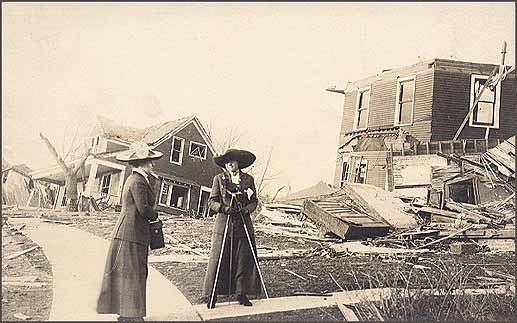|
These intrepid
women are out photographing the aftermath of a devastating tornado in
Omaha, Nebraska.
|
 |
| The following graphic description of
the Omaha Tornado is from "The Story of the Great Flood and Cyclone
Disasters" edited by Thomas H. Russell in 1913. "Death and destruction unparalleled in the history of Omaha, and a property loss even exceeding that of the St. Louis disaster of 1896, traveled with a terrific tornado which mowed a wide and grewsome path through the big Nebraska city late on the afternoon of Sunday, March 23, 1913. A balmy spring day, typical in its fleeting glimpses of the sun and threatening of showers, developed into a driving rain storm and then, in a twinkling of an eye, into a devastating monster of annihilation. And as the dead were carried to the morgues, and the maimed moaned from the wreckage, and the yellow skies glowed with the carmine reflection of hundreds of burned homes, it was recalled that it was Easter Sunday! Cyclonic conditions, unknown to all, prevailed over the Missouri valley during the day, and a gigantic twister suddenly appeared, at 5:45 o'clock, as a manifestation of this disturbance. The wind demon came careering over the prairies from the southwest and drove a diagonal course through the residence district to the northeast, finally crossing the river near the Illinois Central bridge and wreaking its half-spent fury on the city of Council Bluffs. In its wake was left a death list of 115 in Omaha alone,nearly 2,000 ruined homes and a total monetary loss of over $8,000,000 in the metropolis. Before and after blazing its horrid trail through Omaha, the roaring fiend reaped a grim harvest of lives and property in the outlying districts of Nebraska and Iowa, but it was in Omaha that its awful power was felt most keenly. The huge, fashionable residences of the denizens of West Farnam hill suffered alike with the simple cottages of West Side and the substantial homes Bemis Park and northern Omaha. Great industries saw their buildings collapse like cardboard creations of childhood, traffic companies saw their well-oiled systems tied up completely; municipal fire and police departments were made to realize an absolute and humiliating helplessness." |